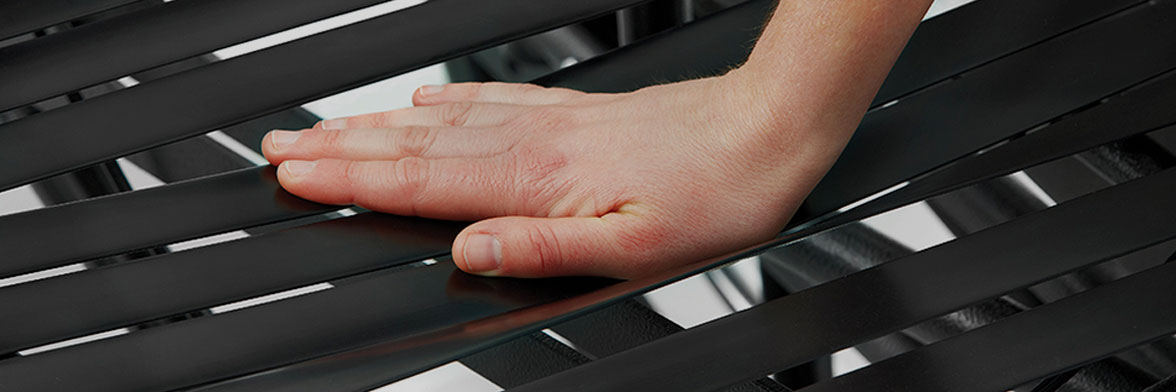The Comfort Tension Seating® system is a distinguishing feature of many Broda wheelchairs, shower commodes, and gliders. Comfort Tension Seating® is made up of individual straps that suspend the weight of the wheelchair user across multiple points. This system works in conjunction with positioning features such as tilt and recline to supply therapeutic pressure relief, enhance postural support, and maintain skin integrity. The straps allow for superior airflow, reducing heat that can build up behind conventional cushions. The Comfort Tension Seating® system also provides a comfort that is superior to Geri chairs and other lower-quality imitations.
What is Comfort Tension Seating® made of?
we make our Comfort Tension Seating® straps with heavy-gauge polyvinyl chloride. Unlike the plastic straps on a beach chair, each Comfort Tension Seating strap responds to body heat and molds to the user’s shape. Comfort Tension Seating® also has memory retention. This means that even after the straps mold to the user, they will return to their original shape within seconds. As a result, this prevents problems that often occur with a typical seat cushion, such as hammocking and bottoming out.
Easy Maintenance & Cleaning
Broda is the exclusive provider of Comfort Tension Seating®. If you maintain your seating system, then it will keep its firmness and resiliency for many years. The straps are resistant to fluids, fungus, and ultraviolet rays, which enhances the durability and extends the lifetime of the straps. If a part of your Comfort Tension Seating® system becomes damaged, it’s easy to fix. There’s no need to buy expensive replacement cushions or a new wheelchair. With Broda, you can replace individual straps on-site. Unlike other wheelchair brands, you don’t have to take the wheelchair out of service. In most cases, you can repair your wheelchair in a matter of minutes!
Safe Use of Cushions with Comfort Tension Seating®
We do not recommend that users sit directly on the Comfort Tension Seating® straps for extended periods of time. Prolonged direct contact with the straps or vinyl could cause the skin to stick to the straps or vinyl. Positioning the user directly on the straps may also result in pinched skin between the straps. With that in mind, make sure the user wears appropriate clothing and uses a cushion. The straps on Broda shower commodes are ideal for bathing, however, and are safe to use for the duration of the hygiene routine.
Cushion Options
For most wheelchair users, we recommend using the Broda padding which comes standard with your wheelchair. We also offer the Slim Posture Padding Package (also known as the SPP), or the Additional Positioning Padding Package (also known as the APP). These packages provide support for advanced positioning needs.
For wound care management, we recommend working with a licensed clinician to choose the right cushion. Keep in mind that padding can affect the wheelchair’s fit. It’s important to ensure that the user is still properly positioned after installing the new cushion.
When adding a cushion to a Broda wheelchair, you may want to make some adjustments. If the seat surface height is affected, then adjust the height of the arm support. We also recommend that the leg supports and foot supports be adjusted to ensure there is no added pressure placed behind the knee and that the calf stays properly placed on the leg and foot supports.
If you have questions about using a cushion with a Broda wheelchair, shower commode, or glider, please call 1 (844) 552-7632 or email customerservice@brodaseating.com.
Are you writing a medical letter of necessity for a patient who needs Comfort Tension Seating®? Click here to read our Clinical Justifications.
